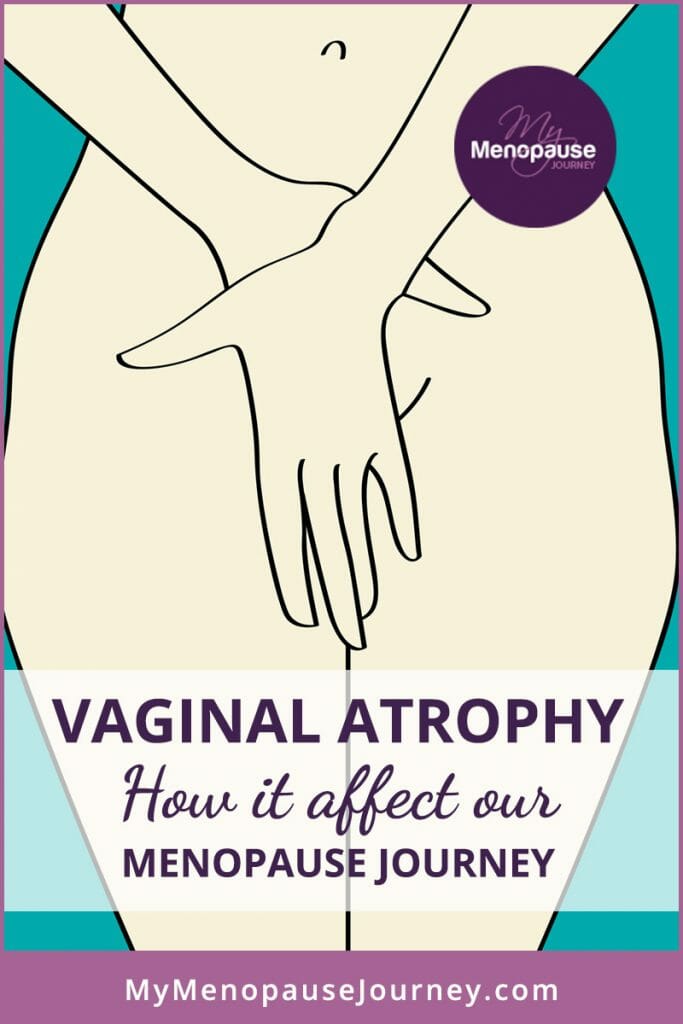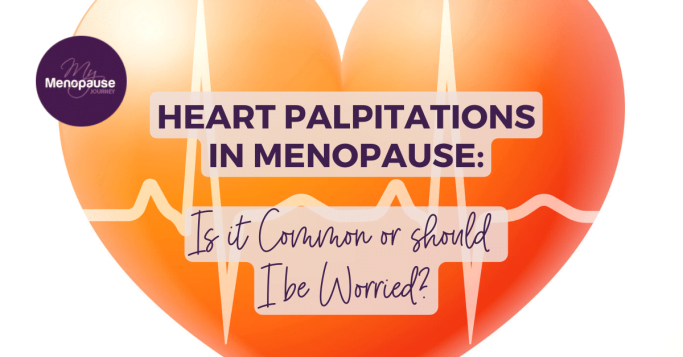Ever heard of vaginal atrophy?
It’s a common condition in menopause that impacts every aspect of our lives. Vaginal atrophy makes our intimate area dry, causes painful sex and even urinary leaking. We may also develop insecurities as a result of vaginal changes. Over 50% of vaginal discomforts are due to vaginal atrophy.
When it comes to menopause symptoms, hot flashes are always in the spotlight. However, we rarely talk about vaginal atrophy or any other subject about sexual health. Guess what? We are going to unravel the nitty-gritty details about vaginal atrophy here!


The vagina is a muscle, and like any other muscle in the body, it also feels the passage of time. The vagina loses its youthful elasticity and natural moisture. It also shrinks and narrows.
Good news is, there are plenty of ways to slow down aging in our intimate area. Of course, we may never get the “vagina of our youth”, but we can still keep it healthy!
How Does Menopause Cause Vaginal Atrophy?
Estrogen, progesterone and testosterone are called sex hormones for a reason! They work together to maintain the health of every organ in our reproductive system.
These hormones increase blood supply, strengthen the walls, maintain pH balance and keep moisture in our vaginal area.
Estrogen, progesterone and testosterone also activate arousal and lubrication during sex.
In menopause, these hormones naturally decrease. As a result, the walls of the vagina thin and secretions cease. Sex becomes painful, and on top of this, low hormones affect libido, so we might avoid having sex. Because of this, some women say that they could live the rest of their lives without sex.
We also become prone to urinary tract infection (UTI). All these contribute to vaginal atrophy.
Sometimes, menopause symptoms such as night sweats, sleep problems and fatigue can affect our mood for sex. Chronic stress is an important factor to consider, as excess cortisol deactivates muscles in the vagina and cause vaginal dryness.
Vaginal atrophy brings a lot of discomforts. Many women say they experience vaginal itching, spotting after sex and burning sensation when they pee. If left untreated, vaginal atrophy can progress and cause urinary incontinence.
Besides, vaginal atrophy changes the appearance of our vagina. The labia, or the folds, become less plump, and they will hang loosely over time. Pubic hair may decrease, and our vagina may appear paler than usual.
Mind-before-body weight loss coach Deborah Murtagh, and OB-GYN, Dr. Jeanie McDonald, talk about what happens in or intimate parts as we age and how we can gain back vitality and pleasure in midlife [47:47]:
Feeling
the midlife shift?
Let’s embrace it together!
Join our Midlife Health Course — a sweet spot for fasting, nutrition, movement and inner peace.
Reclaim your energy and zest for life!


Get Your Vagina Back Using Naturally Proven Solutions for Vaginal Atrophy!
Can we still reverse vaginal atrophy? You bet you can! Sometimes, it’s as easy as having more fun in the bedroom, using that area a little more often and living a healthier life!
Use it or lose it! Say yes to more sexy time and spice things up inside the bedroom! Sex increases blood flow, which nourishes vaginal tissues and makes the vagina more acidic. Spend more time on foreplay, have more sex and experiment with your own sexuality.
Experts say postmenopausal women who have sex more than three times a week have healthier reproductive organs!
Are you saying no because of the pain?
Eat a healthy diet. Consume organic as much as possible and go for hormone-balancing foods. Eat Omega-3 rich food such as salmon, mackerel and tuna. Nuts and seeds are also high in healthy fats, which our body needs to create hormones.
Get more plant-based estrogen in your diet by having more flaxseed, legumes, berries and celery. Make phytoestrogenic and adaptogenic herbs part of your life. Naturopathic doctors recommend Black Cohosh and Magnolia Bark because of their rich phytoestrogen content.
Don’t forget to have more probiotic-rich foods such as kimchi, sauerkraut and kombucha. Hydration is also important!
Supplement! DHEA supplements can help you make more estrogen. They also restore your libido, boost energy and relieve menopause symptoms.
Besides DHEA supplements, natural progesterone creams maintain the health of the vagina. It brings back vaginal moisture and relieves dryness.
Vitamin A, B complex vitamins and beta-carotene help create more hormones because they are rich in omega-3. Consider taking magnesium and zinc, minerals that help build estrogen and progesterone!
Exercise every day. Regular exercise helps maintain blood flow to the vagina and keeps hormone balance by stimulating the ovaries and adrenal glands.
Your Voice Matters to Us!
Is there a question or a topic you want to know more about? Any trend or issue related to women’s health that caught your attention? I am here to dive deep into subjects that matter most to you!
Your insights help us shape our content and we want to serve what truly aligns with your needs!
Let me know how I can better support you and how you would like it delivered. I am all ears and just an email away!
Click on gita@mymenopausejourney.com to share your thoughts, questions or insights!
Every piece of feedback is a gem to us — helping us better connect with you.
With love and gratitude, Gita ♥
Kegel and other pelvic exercises are great for menopausal women! They strengthen our vaginal walls, enhance sexual desire and build our lower core.
Pelvic Floor Physiotherapist, Michelle Kenway, has a great video about pelvic floor exercises for beginners that everyone can follow [7:32]:
Minimize toxin exposure in the vagina! Chemicals from the underwear and products we use can dry out our intimate area. Stay away from commercial washing products, such as perfumed fabric powders and softeners.
Wash and rinse new underwear well; avoid using feminine hygiene products, pads and tampons. It’s also not advisable to shave and wax the intimate area because of irritation and an increased risk of infection.
Good hygiene and comfortable clothing count. Plain water is enough to wash the vaginal area. Avoid washing many times a day and wear underwear in natural fiber. Get rid of tight-fitting garments and change clothes after every exercise.
Use natural moisturizers and lubricants! Gain back natural moisture and lubrication with coconut oil, ghee and emu oil. Coconut oil is rich in healthy fats and nutrients. It also has an antibacterial property.
Emu oil comes from an Australian non-flying bird. This oil has been used by native Australians for 40,000 years because of its powerful anti-inflammatory, protective and healing properties.
Essential oils such as Roman Chamomile, Rose, Lavender, Frankincense and Sandalwood are also excellent natural lubricants. Make sure to use only 1 to 2 drops of these essential oils and dilute them with coconut oil, olive oil or plain distilled water. Essential oils are highly concentrated and can irritate the skin.
Dr. Cabeca shares how to make a DIY natural lubricant in this video using ingredients you have in your kitchen [8:23]:
More Help for Vaginal Atrophy!
Some doctors recommend low dose, local hormone replacement therapy (HRT) and bioidentical hormone replacement therapy (BHRT) to bring back the natural thickness of the vaginal tissues.
Local estrogen in the form of vaginal creams and rings is absorbed deep into the vagina, providing quick relief. Experts say you’ll start to notice an improvement in 3 to 6 weeks. However, the therapy will lose its effects when you stop using it.
Studies say local HRT is safer because the hormone drugs don’t pass the liver or the kidneys. Read our in-depth article about the latest studies and expert opinions on HRT!
Besides HRT and BHRT, state-of-the-art technologies, such as the MonaLisa Touch and Femilift, help reverse the effects of vaginal atrophy. These therapies heat vaginal tissues, which stimulates and forms collagen fibers (proteins that make up our vaginal tissues). This increases blood flow to the vagina, improves lubrication and restores the elasticity of the vaginal walls.
MonaLisa Touch and Femilift are non-invasive laser therapies, which means you don’t have to go under the knife if you want to try them.
Sexual health is a hard topic to talk about. We fear embarrassment, cultural taboo and negative reactions, but it’s time to set aside the awkwardness. Start an open and accepting conversation about vaginal issues – whether it’s with your spouse, health practitioner or other women. Intimacy should be pleasurable and fun!
FACT BOX
What is Vaginal Atrophy?
Atrophy is part of the aging process and it happens anywhere in the body. The term sounds very scientific, but here’s a simple atrophy definition – it’s about a body part shrinking in size.
Vaginal atrophy, or atrophic vaginitis, happens when the vaginal walls shrink, thin and go through inflammation. The main cause of the condition is low sex hormones. However, it can also be due to surgeries, such as removing the ovaries, or therapies like radiation and chemotherapy. Researchers say women who never gave birth are also at risk of vaginal atrophy.
Interested to know about other symptoms? Go to our symptoms page!
Want to understand menopause a bit more? Start on our homepage!
Do you have the symptoms of vaginal atrophy? What did you do about the condition? Tips are appreciated – share in the comment box below ?
Start the conversation about vaginal atrophy. Share this article by clicking on the social icons!
References:
www.dovepress.com/current-treatment-options-for-postmenopausal-vaginal-atrophy-peer-reviewed-fulltext-article-IJWH
clinicaltrials.gov/ct2/show/NCT03547089
www.ncbi.nlm.nih.gov/pmc/articles/PMC4071759/
www.ncbi.nlm.nih.gov/pmc/articles/PMC2800285/
nwhjournal.org/article/S1751-4851(15)30713-3/fulltext





Gita is the founder of My Menopause Journey. Since 2014, she has been supporting midlife women by sharing hard-earned learnings from her own experience. To advance her knowledge, Gita puts a lot of her time and effort into understanding the broad spectrum of women’s health. She immerses in extensive research about the physical, mental and emotional aspects of menopause. Gita believes in the life-changing power of healthy, holistic living — this is where she anchors her message to all women. Learn more about her marvelous mission in About us - My Menopause Journey.